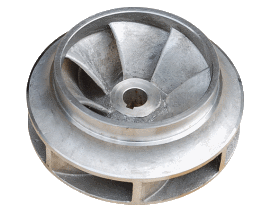Pump Impeller
This is the main rotating parts of the pump that imparts the centrifugal acceleration to the fluid. Impellers may be classified in many ways. For example: According to the direction of liquid flow in reference to the axis of
rotation of the shaft:
Types of Pump Impellers
i) Axial flow
ii) Radial flow
iii) Mixed flow
According on suction type
i) Single suction
ii) Double suction
According to mechanical construction of vanes
i) Closed vane type
ii) Open vane type
iii) Semi open type.
An impeller in a pump is the part that the motor spins and that actually does the work of moving the water. Due to it’s design when the impeller spins it creates a vacuum that pulls the water or liquid in the middle of an opening on the front of the impeller (suction side) and throws it to the outside through the discharge where it is then channeled to the output of the pump.
The impeller is the fan like disc that actually propels the liquid in the pump chamber.
Impeller makes the flow to acquire speed and velocity in a centrifugal pump. The purpose of pump is increasing the pressure of the water.
A centrifugal pump has an intake that allows liquid to enter the pump. Inside of the intake apparatus is a disc with fins which is attached to a motor . The propeller turns at a high speed and gives the ability to pump more water.
Impellers of pumps are classified based on the number of points that the liquid can enter the impeller and also on the amount of webbing between the impeller blades.
Impellers can be either single suction or double-suction. In a single-suction impeller ,liquid enters the center of the blades from only one direction. In a double-suction impeller, liquid enters the center of the impeller blades from both sides at he same time.
Impellers can be open, semi-open, or enclosed. The open impeller consists only of blades attached to a hub. The semi-open impeller is constructed with a circular plate attached to one side of the blades. The enclosed impeller has circular plates attached to both sides of the blades.
The impeller sometimes contains balancing holes that connect the space around the hub to the suction side of the impeller. The balancing holes have a total cross-sectional area that is considerably greater than the cross-sectional area of the annular space between the wearing ring and the hub. The result is suction pressure on both sides of the impeller hub, which maintains a hydraulic balance of axial thrust.
Impellers are selected on the basis of the pump design requires and the application of the pump.
Generally speaking, the higher the number of vanes in the impeller, the greater is the efficiency of the impeller. The performance curve of a pump is also affected by the number of vanes.
The brake horsepower varies as a cube of the impeller diameter.
At Global Pumps & Spares, we keep a full range of Impellers in ready stock.
Impellers are available for Kirloskar Pumps, KSB Pumps, Beacon Pumps, Mather Platt (Wilo) Pumps, etc
Impeller M.O.C. – EN8, EN19, C.I, S.S 410, S.S 304, S.S 316, Bronze etc.
Manufactured from best quality raw materials, the Pump Impeller are available in different grades and sizes as per the needs of our esteemed customers.
More details at http://www.globalpumps.in/impellers.html

